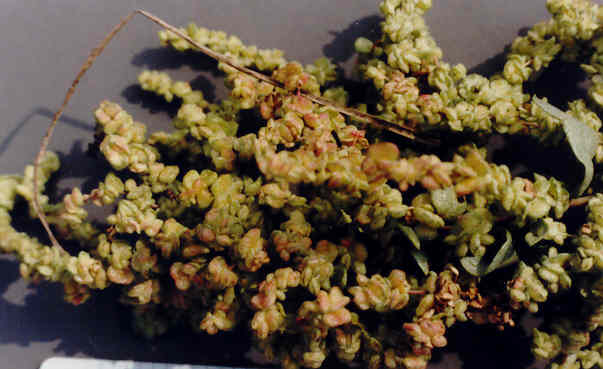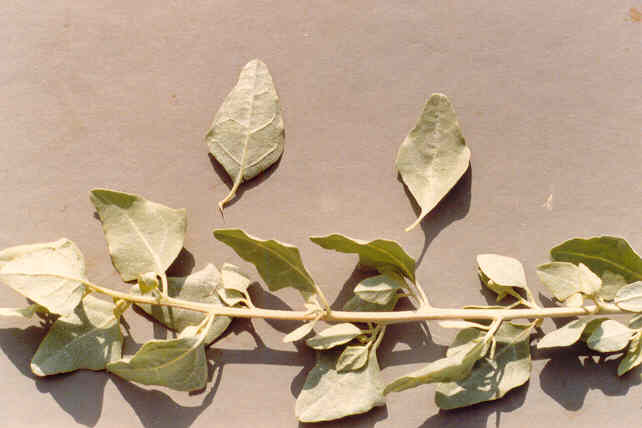
Atriplex lentiformis (Torrey) S. Watson ssp. lentiformis
=Atriplex lentiformis ssp. breweri
Chenopodiaceae (Goosefoot
Family)
Native
 |
Atriplex lentiformis (Torrey) S. Watson ssp. lentiformis=Atriplex lentiformis ssp. breweriChenopodiaceae (GoosefootFamily)Native
Brewer's SaltbushCoast Saltbush |
September Photo
Plant Characteristics:
Erect widely spreading shrub 1-3 m. high, often broader, the twigs
terete, gray-scurfy when young, mostly not spinose; lvs. oblong to
ovate-deltoid, sessile or short-petioled, 3-5 cm. long, 1.5-4 cm. wide, entire,
gray-scurfy; plants monoecious or dioecious, the fl. clusters in profuse
terminal panicles; fruiting bracts convex, 4-7 mm. long, entire or undulate;
seeds brown, ca. 1.4 mm. long.
Habitat:
Saline places; V. Grassland, Coastal Sage Scrub, edge of Coastal Salt
Marsh; Orange Co. and w. Riverside Co. to cent. Calif.; San Clemente Id..
July-Oct.
Name:
Atriplex is the ancient Latin
name for these plants. Lentiformis means "shaped like a lens," referring to the
fruits. (Dale 95).
Breweri, honors William H. Brewer,
1828-1910, collector in California. (Bailey
40).
General:
Common in the study area. Very
common in Big canyon where it has been reintroduced.
Photographed in Big Canyon, along Back Bay Dr. from San Joaquin Hills Dr.
to Big Canyon and on the Santa Ana Heights Flats. In Upper Newport Bay, this plant is usually found above the
line of highest tide, with only the skirts of the lowest plants in the water at
highest tides, however, several plants grow within the tidal zone, several along
the Castaway’s bluffs and one along the path between 23rd. St. and Delhi.
One of the native halophytes found in Upper Newport Bay.
(my comments).
The seeds of A. lentiformis
have been found to contain considerable amounts of ash, protein and oil. Boiling improves the taste of the plants and this and its
numerous relatives make good emergency rations. (Clarke 115).
Some species are said to have been used for arrow foreshafts. (Heizer
& Elsasser 242).
The Cahuilla, Indians of the Colorado Desert, the San Jacinto and San
Bernardino Mountains, collected the seeds of A.
lentiformis in great quantities. They
were collected with a seedbeater and gathering basket and were prepared by
parching, grinding them into flour, and mixing the flour with water to make mush
or small cakes. The leaves of the
plant contain some saponin and were used as soap.
The leaves and roots were crushed and rubbed into articles requiring
cleaning. In addition, the plant
had medicinal uses. Flowers, stems,
and leaves were crushed, steamed and inhaled for the relief of nasal congestion.
Fresh leaves were chewed to relieve head colds.
Dried leaves were smoked for the same purpose.
(Bean 45). The
Yuman- speaking Indians of the Lower Colorado River beat the seeds of Atriplex
lentiformis into a basket with a stick after the November frost turned it
slightly red. The seeds were
pounded, winnowed and then soaked; they were then baked two or three hours in a
hot stone-lined pit covered with moist earth with a fire burning on top. Baked seeds were parched and ground on a milling stone, the
meal was moistened and eaten or boiled into a mush.
(Campbell 166).
Subspecies breweri indistinct
from ssp. lentiformis.
(Hickman, Ed. 1335).
Text Ref:
Dale 95; Jepson 327; Hickman, Ed. 504, 1335; Munz, Flora So. Calif. 355; Roberts 18.
Photo Ref:
Dec 1 82 # 7A; July 2 83 # 9; Oct-Nov 83 # 9; Aug-Sept 87 # 14,15.
Identity: by R. De Ruff, confirmed by F. Roberts.
First Found: December 1982.
Computer Ref: Plant Data 215.
Have plant specimen.
Last edit 6/6/04.
 |
 |
October Photo September Photo